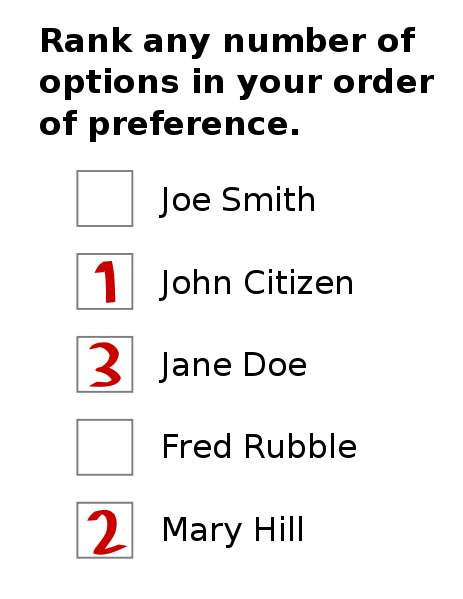
Michael Ossipoff’s Election Methods Properties Series
Main Categories of Properties and Criteria.
2. List of Pass/Fail Criteria That Will Be Used (Without Definitions)
3. Cast of Characters
List of the Methods Being Compared (Without Definitions).
The Section on Each Method Will Conclude With a Compact List of the Names of its Compliances and Desirable Properties.
In topic 4, properties, including criterion-compliances, will be discussed in order of importance starting with the criteria most relevant to strategy. Beginning with a general description of the method’s strategy, I will then discuss other important properties, such as count-fraud vulnerability and enactability, ending with some of the less important criteria.
5. (As Cross-Referencing) Properties and Criteria, With Complying and Failing Methods
Definitions of Any Discussed Properties Not Previously Defined.
6. Conclusions
Where We Are in Voting System Reform. The End of the Proposal-Selection Period is Overdue. Time for the Outreach and Enactment Period.
This article-series compares the properties and criterion-compliances of the voting systems recommended in the Declaration of voting-system reform advocates that can be found at Electorama. The Declaration’s main point is that Plurality (single-mark voting) is having an adverse affect on the political system and on society, and needs to be replaced. The Declaration is right about that. The Declaration recommends several voting systems including Approval, Score (also called “Range”), Condorcet, and Majority-Judgment.
Majority-Judgment (MJ) and the Properties article series
So far, in this Properties article series, I’ve discussed Approval, Score, and two varieties of Condorcet methods—traditional unimproved Condorcet (TUC), and Improved Condorcet. The Declaration-recommended method remaining to be discussed here is Majority-Judgment, and that will be the topic of this article.
All of us who signed the Declaration agree that Plurality should be replaced. But I personally don’t feel that it’s helpful to support a whole set of methods. After all, the need is to choose one. Choosing one means rejecting others. We can’t compare merits without speaking negatively about some proposals. That’s an essential part making a choice. That topic belongs in the last article of this series, but I wanted to mention it now, to explain why I don’t speak favorably about all of the Declaration-recommended methods.
I feel that it would be a disservice to indiscriminately support all of the methods. Instead of merely offering a menu of voting systems, we should look for the best—state what we consider the best proposal, and explain why. A menu doesn’t help in the choice between the voting systems. Some voting-system reform advocates would dilly-dally, dawdle, diddle, and dither forever about the choice of proposals, if left to them. More about that choice later, in the seventh article of this series. Hence my frank criticism of some voting systems. I invite advocates of criticized voting systems to present their counter-arguments, either in the form of an article, or in my articles’ comment space.
In recent articles, I spoke of a traditional unimproved Condorcet (TUC) advocate citing Clone-Independence as an advantage of some TUC methods. But I want to emphasize that not all TUC methods are clone-independent. Beatpath passes Clone Independence. Kemeny fails Clone-Independence. While losing FBC, CD, Later-No-Help, and 0-info Later-No-Help, Kemeny doesn’t gain Clone-Independence in return.
Now, to resume topic #4 in this article-series, evaluating the next method, Majority-Judgment, by the usual properties and criteria:
Majority-Judgment (MJ):
Majority-Judgement Definition:
MJ uses Score balloting. Points-rating. But, instead of summing each candidate’s ratings, MJ finds the median of a candidate’s ratings and uses that as his/her final score. That can result in ties, and so tiebreaking bylaws are needed. The various tiebreaking bylaws define the various versions of MJ. They complicate the definition of MJ. The fact that there are several competing sets of tiebreaking bylaws adds arbitrariness to MJ’s definition.
1. Important Strategy Criteria:
MJ meets FBC and Later-No-Help. Like Approval and Score, but unlike ICT and Symmetrical ICT, MJ doesn’t meet CD. I’ve explained why CD-failure is only a nuisance, rather than a problem. I suggest that no method more elaborate than Approval or Score should be considered unless it meets CD. Majority Judgment is more elaborate than Approval and Score. Majority Judgment fails CD.
Like Approval, Score, ICT, Symmetrical ICT, and Kemeny, MJ doesn’t meet Clone-Independence. I discussed Clone-Independence failure in my previous article. I told why I claim that CD is more important than Clone Independence. ICT meets CD, though not Clone-Independence. Majority-Judgment meets neither. Like Approval and Score, but unlike TUC, ICT and Symmetrical ICT, MJ doesn’t meet the Condorcet Criterion.
General Strategy Description of Majority-Judgment:
Let’s start with MJ’s intent and rationale. The idea is that voters will rate sincerely. What MJ advocates mean by sincere rating is rating that attempts to express how good the candidates are. Rating proportional to perceived or estimated utilities of the candidates. The question is: How good is the match between rationale and reality? Let’s find out:
Suppose that you and one other voter are the only people who haven’t voted yet. You both share the same favorite and second choice. I’ll call them Favorite and Compromise. Before you vote, your favorite is the winner. You both show up and vote. You give top rating to your favorite. Voting sincerely, you give a slightly lower rating to your second choice. As I said, MJ scores each candidate by the median of its ratings. Now, suppose that, before you vote, Favorite and Compromise both have medians lower than the ratings that you give to them. When you and your friend vote, you pull both of their medians up by one voter.
Here’s what I mean by that: The median of a candidate’s ratings is a rating such that half of his/her ratings are higher, and half are lower. When you and your friend give him/her a higher rating, that raises his/her median to a value that is just above his/her next highest rating. That’s what I mean when I say that you raise his/her median by one voter.
But there’s no reason to believe that, in the ratings-range in which Favorite and Compromise lie, that the voters’ ratings of Favorite and Compromise will be equally spaced. Most likely not. That means that raising both candidates by one voter might actually raise them by different distances when measured in terms of rating-number. For instance, it might raise Compromise more than it raises Favorite. Maybe Favorite was only a little above Compromise. After you and your friend vote and raise Compromise more than Favorite, Compromise’s median is above Favorite’s median.
So, by showing up and voting, and voting Favorite above everyone, you’ve made Favorite lose. You did that by raising Compromise more than Favorite, when rating Favorite above Compromise—when rating Favorite alone at top-rating. So much for sincere ratings having results that reflect your sincere intent. I’ll refer to this later, as a failure of the Participation Criterion. The above-described failure won’t ever happen with Approval or Score.
I emphasize that we needn’t only talk about only two voters. We could just as well speak of a whole faction. If so, then Favorite might be well above Compromise before your faction votes, but your faction raises Compromise so much more than Favorite that you change the winner from Favorite to Compromise.
Additionally, say X is your 2nd choice and Y is your last choice. Maybe X and Y are the contenders for the win. You rate Y at bottom. You rate X somewhat down in the rating scale. Both X and Y, before you vote, have medians higher than your ratings of them. So you’re pulling them both down. Ideally, you’d be pulling them down equally. In other words, your rating X over Y would count for nothing. But it can be worse than that. For the reasons described above, you could be pulling X down farther than Y. And so, if X would have won, had you not voted, you could be changing the winner from X to Y.
If you say that Majority-Judgment is a capriciously unresponsive mess, you’re right. What do MJ advocates have to say about that? Well, they assure us that maybe sometimes that won’t happen :-)
But what’s the rationale of MJ? As I said, their presumption is that everyone will rate sincerely. They emphasize that even the most extreme high or low rating won’t change a candidate’s median any more than a rating that is barely above or below his/her median. That’s touted as something that will encourage sincere rating, by which they mean ratings proportional to perceived utility. I haven’t been able to get an answer regarding just why these sincere ratings are desired, but presumably the idea is that utility-proportional ratings are easier because they aren’t strategic.
Therefore, an extreme high or low rating won’t change a candidate’s median any more than will a rating barely above or below his/her previous median, This means that you can’t give fractional support, fractional ratings, as you can in Score. Evidently, MJ advocates want to call that an advantage. In previous articles I discussed the use and value of fractional ratings in Score. But here’s a bit of somewhat good news about MJ:
If you rate only at the extremes, top, and bottom, MJ is (a little) like Approval. Extreme rating is optimal in MJ. It’s your best way to vote. Just as in Score. But, of course, a difference between MJ and Score is that rating two candidates at top, in MJ, can pull them up by different amounts, due to MJ’s capricious unresponsiveness. MJ, even when voted at extremes, isn’t Approval.
Usually or always, the definition of MJ stipulates that the ballots’ ratings be labeled in emotionally evaluative terms. For instance, maybe the school grades between A at top and F at bottom. (In the U.S., school grades are: A, B, C, D, and F (in descending order). The reason why E is absent is because 5 grades are desired, and F stands for “failure”.) Or maybe Strongly Support, Support, Indifferent, Oppose, Strongly Oppose.
In other words, emotionally expressive, utility-proportional, ratings are expressly required in MJ, as it’s usually or always defined. In other words, as usually or always defined, MJ calls for voters to vote sub-optimally. By the way, an ideally practical labeling system for Score ratings would be:
1.0 (Above Expectation)
.9
.8
.7
.6
.5
.4
.3
.2
.1
0 (Below Expectation)
That ratings-labeling system acknowledges that one should give top rating to above-expectation candidates and bottom rating to below-expectation candidates. Sometimes, due to uncertainty about which extreme rating to give, or for chicken-dilemma strategy reasons (Strategic Fractional Ratings or SFR), it’s desirable to give fractional ratings, for which reason the in between fractional ratings are available. The ballot would make it clear that that is the purpose of the in between fractional ratings.
In Majority Judgment, give in between ratings at your own risk. This concludes the general strategy discussion of Majority Judgment.
Social Optimizations
MJ doesn’t have social optimizations. Approval and Score have social optimizations that I’ve described.
- Ease of Implementation, and Count-Fraud Vulnerability:
In that regard, MJ is equal to Score. This means that a lot better than the rank methods, and not nearly as good as Approval.
- Enact-ability:
Poor. MJ has none of Approval’s and Score’s simplicity, obviousness and naturalness. I’ll repeat here two things that I mentioned above. And MJ’s need for tiebreaking bylaws complicates MJ’s definition quite a bit. And, because there are several competing tiebreaking bylaws for MJ, that introduces an element of arbitrariness to MJ.
- Embarrassment Criteria:
Like Approval and Score, MJ meets IIAC. Unlike Approval and Score, MJ fails Participation and Consistency. I described MJ’s dramatic, embarrassing and outrageous Participation-failure earlier in this article, under General Strategy Description. As I mentioned before, Approval and Score, in addition to meeting Participation, also meet the more demanding Mono-Add-Top. Because MJ fails Participation, it also fails Mono-Add-Top.
Some MJ advocates claim that MJ meets the Mutual Majority Criterion. Among the methods that have been discussed at Democracy Chronicles, Beatpath and IRV meet Mutual Majority. Contrary to its advocates’ claims, MJ fails Mutual Majority.
In the article about traditional unimproved Condorcet (TUC), I mentioned that at least some TUC methods (such as Beatpath) meet Mutual Majority. I also expressed my claim that compliances with the Condorcet Criterion, the Smith Criterion, Condorcet Loser, and Mutual Majority are made meaningless and worthless by the drastic distortion of voters’ preferences resulting from the strategy-needs resulting from the TUC methods’ failure of FBC and CD.
Likewise, of course, it is the same for IRV’s failure of FBC (at least with existing electorates, with their over-compromising tendency). Having mentioned MMC, I should define it:
Mutual Majority Criterion:
If a set of voters, consisting of more than half of the voters, all prefer the candidates in set S to all of the candidates outside S, and if that set of voters vote sincerely, then the winner should come from S.
Though some MJ advocates claim that MJ meets MMC, a simple example shows that it doesn’t:
| Candidate X | Candidate Y | |
| One Voter | 10 points | 9 points |
| One Voter | 1 point | 0 points |
| One Voter | 0 points | 10 points |
X’s median: 1 point
Y’s median: 9 points
Y wins. The two X voters are a two-thirds majority. They both preferred X to Y and voted sincerely. MMC therefore requires X to win. But Y wins. MJ fails MMC. This has been the evaluation of Majority-Judgment by the usual properties and criteria.




Stephen Bosworh says
In the 4th paragraph of your above General Strategy Description of MJ section, you offer an outline of how two votes might vote in such a way as to unintentionally defeat their ‘favorite’. If would help me better to understand your point if you could please provide me more details about the context in which this takes place: Please make it clear which of the many candidates currently has the highest median-grade before and after these two citizens vote. At the same time, please specify the exact grades each of these two gave to the relevant candidates (Excellent, Very Good, Good, Acceptable, Poor, or Reject).
Thank you,
Steve,
stevebosworth@hotmail.com